4 min read
Agriculture is one of the world’s largest industries, providing daily sustenance and livelihoods for millions. However, there are growing concerns about agriculture’s contribution to climate change as the sector accounts for over 70% of freshwater use and 23% of greenhouse gas emissions.
Agri-businesses now face the challenge of how to sustain life for both the planet and people, with the global population expected to increase by 2 billion by 2050. This problem is even more pressing for Asia as the region has to feed half of the global population with only a quarter of the world’s agricultural land.
Given the increasing momentum of ESG (Environmental, Social, and Governance) investment, agriculture stakeholders in Asia are presented with a golden opportunity to revolutionize the current food system for a growing and hungry population.
Boosting the agriculture industry through blended financing
Investing in agriculture is often seen as risky. It is difficult for farmers to change long-standing farming practices, and so transitioning to more sustainable methods will require a lot of capacity building and technical assistance. This is especially true for smallholder farmers who dominate the food industry in Asia.
Arindom Datta, Executive Director and Head of Rural and Development Banking of Rabobank, a global leader in food and agriculture financing, believes that corporations and private investors must collaborate with farmers and grassroots agencies to harness the potential of agri-food projects. This collaborative approach of bringing together different pools of commercial and non-commercial capital along with support from local communities, is known as blended financing.
For example, the Singapore government was able to boost local food supply by offering de-risking grants to agri-businesses with novel technologies to reach commercialization. This aligns with Sustainable Development Goal 17: Partnerships for the Goals, where many different stakeholders in the public, private, and people sectors must come together in order to transform the global food system.
Harnessing technology to transform the food supply chain
Innovative technology can transform the way that food is being produced, processed, and consumed. John Friedman believes that “technology is the tool to unlock potential”. He is the Asia Director of AgFunder and GROW Accelerator, Southeast Asia’s leading agri-food tech accelerator, which supports developments such as seed genomics and alternative proteins – the new frontier of food.
As important as R&D is supply chain management, where new technologies have helped to improve tracking and traceability as well as reduce transaction costs across the food supply chain.
Cultivating sustainable agriculture using ESG-focused solutions
There has been a shift in capital across the spectrum of funders to adopt a more conscious allocation of funds through ESG investing. Investments in the agriculture sector have been increasing, with early-stage venture capital investments in agri-food tripling to $26 billion from 2015 to 2020.
However, Asia still lags behind the US and Europe in our ESG efforts. There is a need “to turn ESG from a fleeting trend to a tangible reality” as expressed by Ivy Wong, who is currently the Lead of Environment Pillar at Yayasan Hasanah. Yayasan Hasanah is an impact-based foundation that strives to create positive social and environmental change for Malaysia.
This sentiment is echoed by Sutedjo Halim, the Managing Director for Trading, Downstream and Sustainability at PT Triputra Agro Persada Group, a big player in Indonesia’s food commodity industry. With their mission “to feed the world”, the Group promotes that sustainability and ESG must be an inherent aspect of all agri-businesses.
Investment in sustainable and socially inclusive agriculture is not only a critical need but also an exciting endeavour for agriculture stakeholders to transform a sector with large commercialization potential for the Asian market.
This blog is adapted from the “Building sustainable agri-businesses in Asia through ESG-focused practices and solutions” webinar as part of the Sustainability Dialogues series, brought to you by the AVPN Climate Action Platform. This Platform aims to provide Asia-based businesses and financial organizations insights and practical guidance on what ESG means for them in the context of the current crisis and beyond.


















